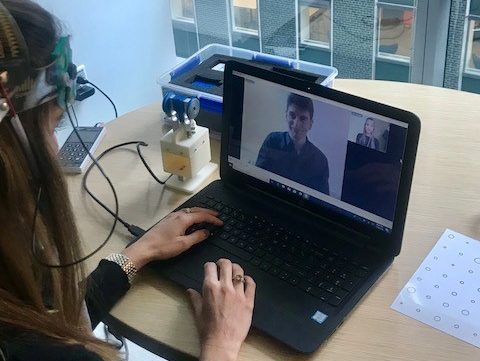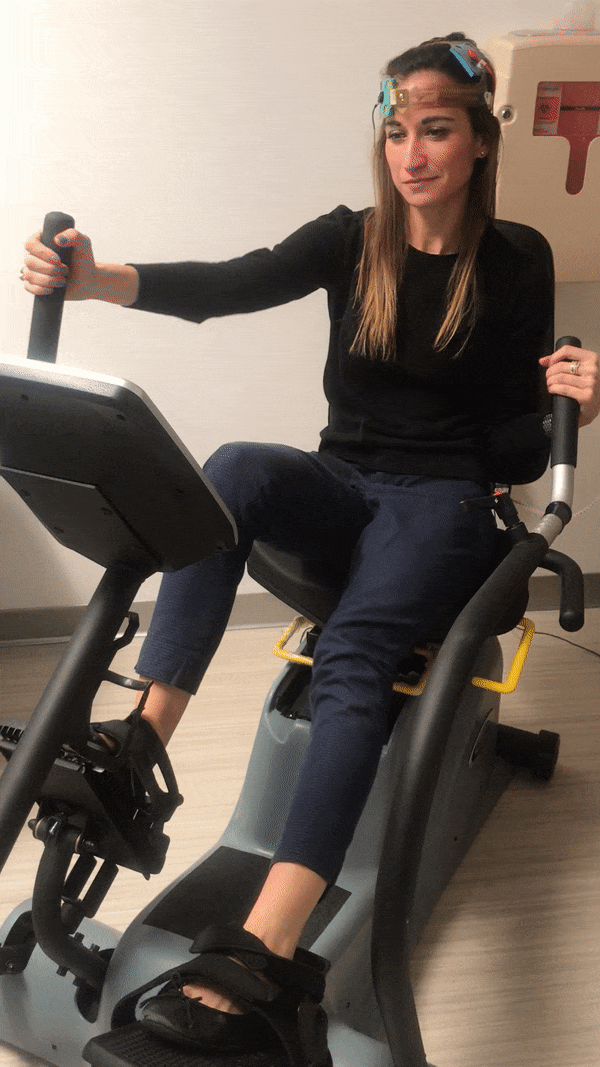
Transcranial direct current stimulation (tDCS) is a type of noninvasive brain stimulation where a mild electrical current is passed through two or more scalp electrodes placed to target a specific brain region. There are early signs of therapeutic benefit using tDCS, both to improve symptoms across central nervous system (CNS) disorders (e.g., depressed mood), but especially to enhance training outcomes when paired with a rehabilitative activity (e.g., cognitive or motor exercises). tDCS is presumed to increase the brain’s plasticity during the stimulation period, with repeated application or treatment yielding the most consistent persisting effects in brain excitability and clinically relevant effects.
tDCS is appealing because it is safe, tolerable, and relatively low cost. In addition, the devices are lightweight and portable allowing for flexibility in therapeutic delivery.
tDCS for motor rehabilitation with remote supervision
Basic and clinical studies clearly point to a cumulative benefit of repeated stimulation. Therefore, to achieve optimal and persisting clinical benefit, many tDCS treatments are needed. Programs of rehabilitative exercise can span weeks or months of daily practice.

It is simply not feasible for the majority of participants to travel to a clinic to receive multiple daily sessions. For our center in NYC, the average commuting time for a visit is over two hours, and can be expensive. This is a hardship for people who are busy with work and family duties, as well as those who are challenged with travel.
As a solution, we have developed a method to deliver treatment away from the clinic using remote supervision (remotely supervised or RS-tDCS). Using a telemedicine platform significantly increases access to treatment, and we have found that participants have higher rates of compliance and protocol adherence when they can receive treatment at home.
Rather than self-directed home use, we carefully replicate the clinic administration practices in their home through real-time instruction and monitoring via videoconference, and rigorously structured methods. It is very important to note that our remote supervision maintains the same clinic standards for monitoring, safety, and treatment procedures.
Safety features and process of tDCS with remote supervision
The stimulation devices used in our trials are explicitly designed for remote use, and we are live with the participant for the entire session. To ensure that the scalp electrodes are reliably placed, we have an elasticized head-strap with markers to confirm the correct location by both the participant and technician throughout the videoconference. Each device is locked by programmable dose-release codes that are one-time use. We control how many codes are programmed for each device and we verbally state the dose-release code to the participant when they are fully prepared to begin their treatment and have met all safety checks.
Being able to monitor each participant remotely with video-conferencing software allows us to control when treatment is delivered to the participant and we are able to address any problems that may arise during the treatment session immediately. Importantly, if contact between the electrodes is disrupted or if there is impedance then the stimulation will cease. The devices provide reliable control over the intensity and timing of stimulation with a continuous visual indication of electrode contact quality while stimulation is active.
Remotly supervised tDCS for Parkinson’s disease and multiple sclerosis – generaliziability of the protocol
The aim of this particular study was to demonstrate its feasibility in participants with Parkinson’s disease (PD). This was found to be the case, at-home access for PD patients led to exceptionally high protocol compliance. The preliminary results in the PD population confirmed the generalizability and utility of our RS-tDCS protocol while indicating preliminary efficacy of tDCS for the improvement of perceived fatigue and cognitive processing speed.
It was remarkable how much the PD participants appreciated the opportunity to access treatment from home, and it was an immediately popular study.
We have previously established that our protocol is very successful for providing at-home tDCS to people with multiple sclerosis (MS), across a wide range of ages (18 to 75 years) and disability levels (including those who are wheelchair dependent and rely on a caregiver). The protocol enables effective study of the long-term effects of tDCS and we are now administering up to 60 sessions in some participants, paired both with cognitive or motor training.
We moved on to compare our findings with this PD cohort to our previous MS cohorts, and determined that our RS-tDCS protocol had similar benefits and side effects for people across these neurological diseases.
It was remarkable how much the PD participants appreciated the opportunity to access treatment from home, and it was an immediately popular study. As would be expected when living with a movement disorder, and like many of our MS participants, it is quite a burden to travel to and from clinic each day. For instance, one participant comes to mind who would clearly not have otherwise been able to access therapy at all as he could not travel to his appointments alone and his spouse had a very busy work schedule. He reported feeling increased alertness after each session and was very interested in any opportunity to extend his treatment sessions (as many are). We also found that participants especially liked a nondrug option for therapy.
Future perspective for tDCS application for Parkinson’s diseases
Our findings support further study of the effects of tDCS for the PD population, and we believe that the RS-tDCS method can allow for large-scale studies with adequate sample sizes and extended session to inform the parameters for clinical use such as dosing. We hope to expand and demonstrate the feasibility of our RS-tDCS protocol across neurological disorders in order to reach those that may most benefit from this treatment in the future.
Comments